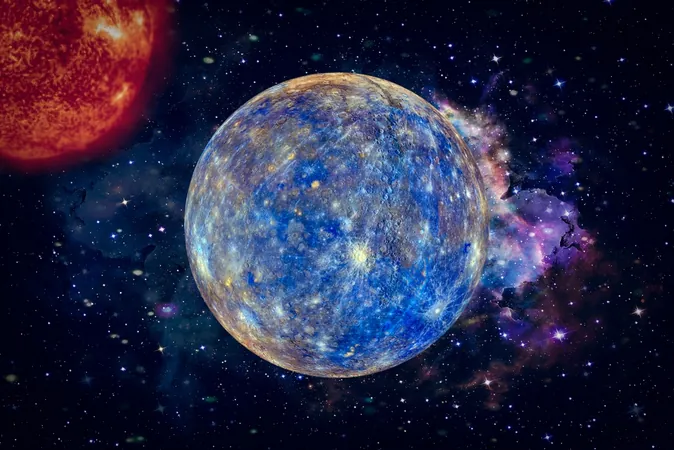
BepiColombo Mission to Mercury Set to Unlock Secrets of Planet Formation by 2026!
2025-01-10
Author: Siti
The groundbreaking BepiColombo mission, a collaborative effort between the European Space Agency (ESA) and the Japan Aerospace Exploration Agency (JAXA), is poised to revolutionize our understanding of the Solar System. Launched on October 20, 2018, BepiColombo is currently in the cruise phase and is expected to arrive at Mercury in late 2026.
As only the third spacecraft ever to reach Mercury, BepiColombo is set to uncover new insights into the planet's composition, structure, and atmosphere, along with its enigmatic magnetic field. Its arrival will mark a significant milestone in planetary exploration, illuminating our understanding of how rocky planets have formed and evolved throughout the Solar System's history.
The Challenges of Exploring Mercury
Mercury presents unique challenges for mission planners due to its harsh environment. Being almost as dense as Earth yet only slightly larger than our Moon, the planet's high density is believed to be a result of its substantial iron core. The surface is riddled with massive craters, a testament to the intense bombardment it sustained during the early days of the Solar System, around four billion years ago. With temperatures soaring to a scorching 350°C and fierce sunlight, BepiColombo faces one of the toughest environments in space exploration.
Advanced Technology for an Ambitious Journey
To tackle these challenges, BepiColombo employs cutting-edge technology, including an advanced ion propulsion system. This technology is a significant leap, building on experiences from previous missions like SMART-1. It harnesses electricity from solar panels to generate charged particles from xenon gas, which are expelled to provide thrust. The mission will also utilize gravity assists from the Moon, Earth, and Venus, enhancing its trajectory towards Mercury.
The BepiColombo spacecraft consists of several critical components: - **Mercury Transfer Module (MTM)**: Responsible for transporting the spacecraft to Mercury. - **European Mercury Planetary Orbiter (MPO)**: Equipped with 11 scientific instruments aimed at studying Mercury from a low-polar orbit. - **Japanese Mercury Magnetospheric Orbiter (MMO)**: Focused on analyzing the planet's magnetic environment with five specialized instruments.
The MPO will utilize the Mercury Imaging X-ray Spectrometer (MIXS) to measure fluorescent X-rays reflected from Mercury's surface, enabling scientists to better understand its elemental and mineral composition. Meanwhile, the MMO will delve into the curious magnetic field of Mercury, challenging existing theories about how such a small planet can maintain this phenomenon.
Significant UK Contributions to the Mission
The BepiColombo mission also highlights crucial contributions from the UK. Scientists from the University of Leicester played a pivotal role in developing MIXS, enabling researchers to uncover Mercury's surface composition and its formation narrative.
Airbus Defence and Space (Germany) led the construction of the European components, with Airbus UK providing vital spacecraft structures and systems. QinetiQ UK contributed the innovative electric propulsion system, allowing for efficient space travel. Additionally, SEA Ltd (now Thales Alenia Space UK) supplied important equipment for sensor data acquisition, ensuring that the spacecraft operates effectively during its mission.
The Countdown to Discovery
As BepiColombo approaches its arrival at Mercury, anticipation builds among scientists and space enthusiasts alike. This mission not only promises to expand our knowledge of Mercury but may also provide invaluable insights into the formation of Earth and the other terrestrial planets. Prepare for a new era of planetary discovery that could redefine our understanding of the Solar System’s rocky worlds!

 Brasil (PT)
Brasil (PT)
 Canada (EN)
Canada (EN)
 Chile (ES)
Chile (ES)
 Česko (CS)
Česko (CS)
 대한민국 (KO)
대한민국 (KO)
 España (ES)
España (ES)
 France (FR)
France (FR)
 Hong Kong (EN)
Hong Kong (EN)
 Italia (IT)
Italia (IT)
 日本 (JA)
日本 (JA)
 Magyarország (HU)
Magyarország (HU)
 Norge (NO)
Norge (NO)
 Polska (PL)
Polska (PL)
 Schweiz (DE)
Schweiz (DE)
 Singapore (EN)
Singapore (EN)
 Sverige (SV)
Sverige (SV)
 Suomi (FI)
Suomi (FI)
 Türkiye (TR)
Türkiye (TR)
 الإمارات العربية المتحدة (AR)
الإمارات العربية المتحدة (AR)